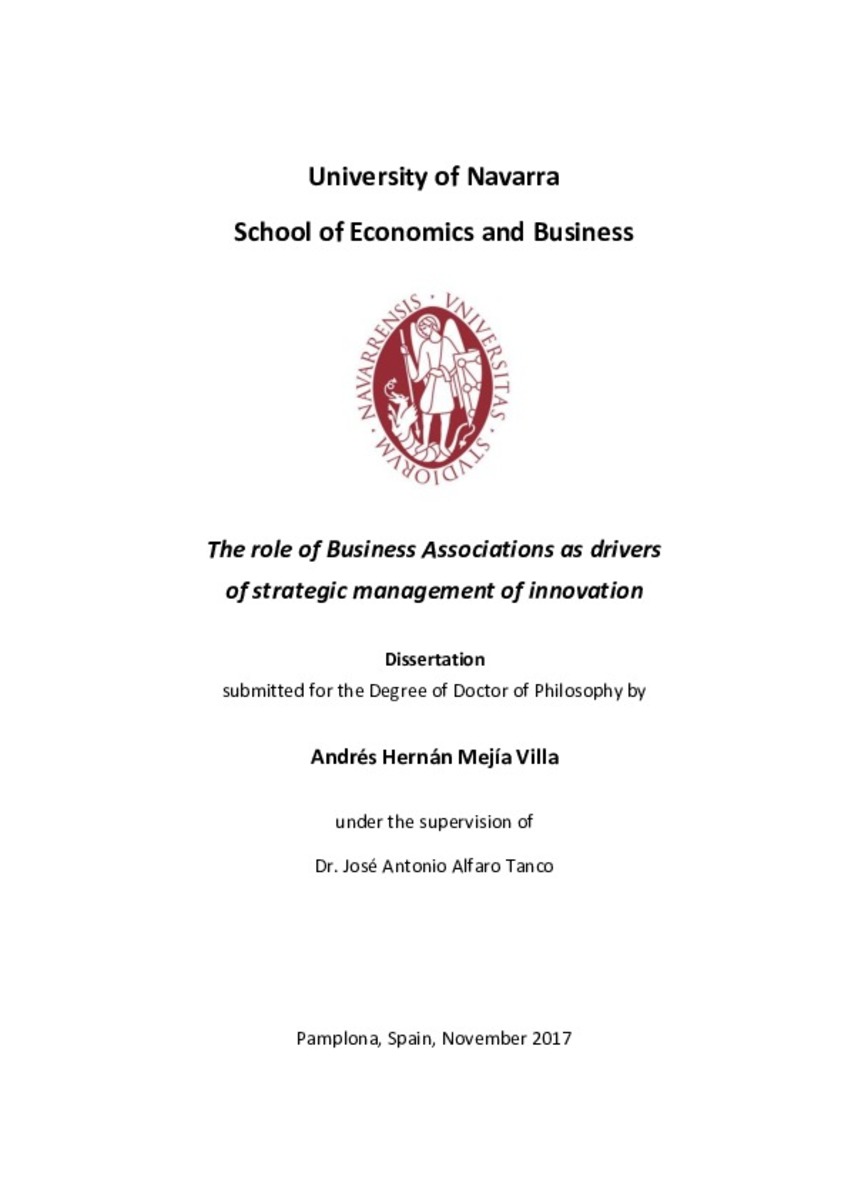Full metadata record
| DC Field | Value | Language |
|---|---|---|
| dc.contributor.advisor | Alfaro, J.A. (José Antonio) | - |
| dc.creator | Mejía-Villa, A. (Andrés) | - |
| dc.date.accessioned | 2018-01-30T17:32:43Z | - |
| dc.date.available | 2018-01-30T17:32:43Z | - |
| dc.date.issued | 2018-01-30 | - |
| dc.date.submitted | 2017-12-15 | - |
| dc.identifier.citation | MEJÍA-VILLA, Andrés Hernán. "The role of Business Associations as drivers of strategic management of innovation". Alfaro Tanco, J.A. (dir.). Tesis doctoral. Universidad de Navarra, Pamplona, 2017. | es_ES |
| dc.identifier.uri | https://hdl.handle.net/10171/46607 | - |
| dc.description.abstract | Traditionally, business associations have been representatives of the interests of companies. Additionally, they have become coordinators of business activity and facilitators of the flow of information in the industry. Currently, the associations go further, they are developing a new role as innovation intermediaries for their affiliated companies. This work, although very valuable is not evident, therefore, they suffer from invisibility for business and academic organizations. Consequently, this doctoral thesis aims to deepen the study of the role of associations as key agents of the processes of open and collaborative innovation in business ecosystems, that is denominated innovation intermediation. In order to meet this challenge, we developed an Action Research project with three phases that comprise the articulation of a theoretical framework, and two fieldworks with a group of associations from the community of Navarra (northern Spain). In the first phase, we present a robust theoretical framework on the strategic, innovation and creativity aspects that surround the dynamics of associations as innovation intermediaries. Likewise, we clarify the fundamental concepts of associations as organizations of a social and economic nature. Finally, we describe their new role as facilitators of the strategic innovation of companies in the industrial sectors. In the second phase, we designed and applied a survey of 21 business associations, which allowed us to define their innovation intermediation functions, the types of innovation they tend to promote among their companies, and their dynamic capacities for innovation intermediation. Subsequently, we performed a cluster analysis to propose a typology of business associations. Finally, as a result of the previous findings, in the third phase we carried out an interactive and participative work with managers from 16 associations that allowed us to propose a Maturity Model of Innovation Intermediation Capacity, and also to propose the concept of business associations as Communities of Collaborative Innovation. | es_ES |
| dc.language.iso | eng | es_ES |
| dc.rights | info:eu-repo/semantics/openAccess | * |
| dc.subject | Business associations | es_ES |
| dc.subject | Innovation | es_ES |
| dc.subject | Materias Investigacion::Economía y Empresa | es_ES |
| dc.title | The role of Business Associations as drivers of strategic management of innovation | es_ES |
| dc.type | info:eu-repo/semantics/doctoralThesis | es_ES |
Files in This Item:
Statistics and impact
Items in Dadun are protected by copyright, with all rights reserved, unless otherwise indicated.






